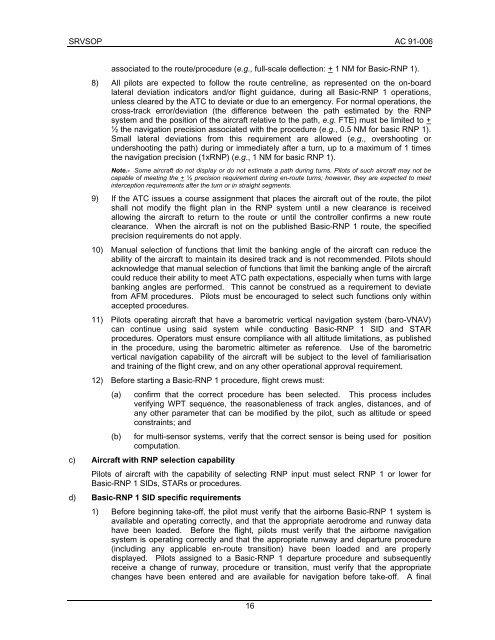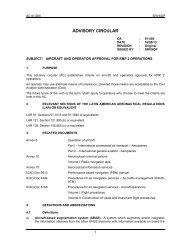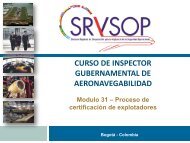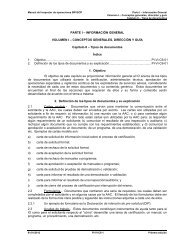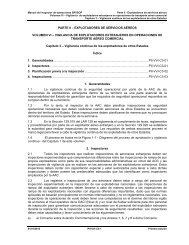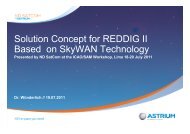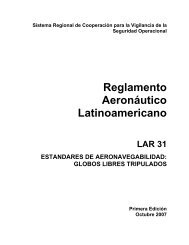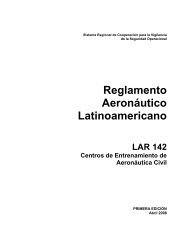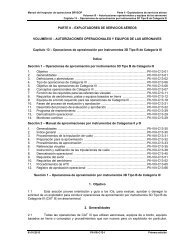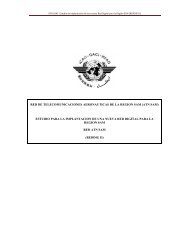ac 91-006 srvsop - ICAO
ac 91-006 srvsop - ICAO
ac 91-006 srvsop - ICAO
You also want an ePaper? Increase the reach of your titles
YUMPU automatically turns print PDFs into web optimized ePapers that Google loves.
SRVSOP AC <strong>91</strong>-<strong>006</strong><br />
associated to the route/procedure (e.g., full-scale deflection: + 1 NM for Basic-RNP 1).<br />
8) All pilots are expected to follow the route centreline, as represented on the on-board<br />
lateral deviation indicators and/or flight guidance, during all Basic-RNP 1 operations,<br />
unless cleared by the ATC to deviate or due to an emergency. For normal operations, the<br />
cross-tr<strong>ac</strong>k error/deviation (the difference between the path estimated by the RNP<br />
system and the position of the aircraft relative to the path, e.g. FTE) must be limited to +<br />
½ the navigation precision associated with the procedure (e.g., 0.5 NM for basic RNP 1).<br />
Small lateral deviations from this requirement are allowed (e.g., overshooting or<br />
undershooting the path) during or immediately after a turn, up to a maximum of 1 times<br />
the navigation precision (1xRNP) (e.g., 1 NM for basic RNP 1).<br />
Note.- Some aircraft do not display or do not estimate a path during turns. Pilots of such aircraft may not be<br />
capable of meeting the + ½ precision requirement during en-route turns; however, they are expected to meet<br />
interception requirements after the turn or in straight segments.<br />
9) If the ATC issues a course assignment that pl<strong>ac</strong>es the aircraft out of the route, the pilot<br />
shall not modify the flight plan in the RNP system until a new clearance is received<br />
allowing the aircraft to return to the route or until the controller confirms a new route<br />
clearance. When the aircraft is not on the published Basic-RNP 1 route, the specified<br />
precision requirements do not apply.<br />
10) Manual selection of functions that limit the banking angle of the aircraft can reduce the<br />
ability of the aircraft to maintain its desired tr<strong>ac</strong>k and is not recommended. Pilots should<br />
<strong>ac</strong>knowledge that manual selection of functions that limit the banking angle of the aircraft<br />
could reduce their ability to meet ATC path expectations, especially when turns with large<br />
banking angles are performed. This cannot be construed as a requirement to deviate<br />
from AFM procedures. Pilots must be encouraged to select such functions only within<br />
<strong>ac</strong>cepted procedures.<br />
11) Pilots operating aircraft that have a barometric vertical navigation system (baro-VNAV)<br />
can continue using said system while conducting Basic-RNP 1 SID and STAR<br />
procedures. Operators must ensure compliance with all altitude limitations, as published<br />
in the procedure, using the barometric altimeter as reference. Use of the barometric<br />
vertical navigation capability of the aircraft will be subject to the level of familiarisation<br />
and training of the flight crew, and on any other operational approval requirement.<br />
12) Before starting a Basic-RNP 1 procedure, flight crews must:<br />
(a) confirm that the correct procedure has been selected. This process includes<br />
verifying WPT sequence, the reasonableness of tr<strong>ac</strong>k angles, distances, and of<br />
any other parameter that can be modified by the pilot, such as altitude or speed<br />
constraints; and<br />
(b) for multi-sensor systems, verify that the correct sensor is being used for position<br />
computation.<br />
c) Aircraft with RNP selection capability<br />
Pilots of aircraft with the capability of selecting RNP input must select RNP 1 or lower for<br />
Basic-RNP 1 SIDs, STARs or procedures.<br />
d) Basic-RNP 1 SID specific requirements<br />
1) Before beginning take-off, the pilot must verify that the airborne Basic-RNP 1 system is<br />
available and operating correctly, and that the appropriate aerodrome and runway data<br />
have been loaded. Before the flight, pilots must verify that the airborne navigation<br />
system is operating correctly and that the appropriate runway and departure procedure<br />
(including any applicable en-route transition) have been loaded and are properly<br />
displayed. Pilots assigned to a Basic-RNP 1 departure procedure and subsequently<br />
receive a change of runway, procedure or transition, must verify that the appropriate<br />
changes have been entered and are available for navigation before take-off. A final<br />
16


